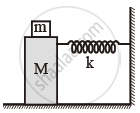Advertisements
Advertisements
Question
The length of a second’s pendulum on the surface of earth is 1 m. What will be the length of a second’s pendulum on the moon?
Solution
A second's pendulum means a simple pendulum having a time period T = 2 s.
For a simple pendulum, T = `2pisqrt(l/g)`
Where, `l` = Length of the pendulum
And g = Acceleration due to gravity on surface of the earth
`T_e = 2pisqrt(l_e/g_e)` .......(i)
On the surface of the moon, `T_m = 2pisqrt(K_m/g_m)` ......(ii)
∴ `T_e/T_m = (2pi)/(2pi) sqrt(l_e/g_e) xx sqrt(g_m/l_m)`
Te = Tm to maintain the second pendulum time period.
∴ 1 = `sqrt(l_e/l_m xx g_m/g_e)` ......(iii)
But the acceleration due to gravity on the moon is 1/6 of the acceleration due to gravity on earth,
i.e., `g_m = g_e/6`
Squaring equation (iii) and putting this value.
1 = `l_e/l_m xx (g_e/6)/g_e = l_e/l_m xx 1/6`
⇒ `l_e/(6l_m)` = 1
⇒ `6l_m = l_e`
⇒ `l_m = 1/6 l_e = 1/6 xx 1 = 1/6 m`
APPEARS IN
RELATED QUESTIONS
If the metal bob of a simple pendulum is replaced by a wooden bob of the same size, then its time period will.....................
- increase
- remain same
- decrease
- first increase and then decrease.
The acceleration due to gravity on the surface of moon is 1.7 ms–2. What is the time period of a simple pendulum on the surface of moon if its time period on the surface of earth is 3.5 s? (g on the surface of earth is 9.8 ms–2)
Answer the following questions:
A man with a wristwatch on his hand falls from the top of a tower. Does the watch give correct time during the free fall?
Answer the following questions:
What is the frequency of oscillation of a simple pendulum mounted in a cabin that is freely falling under gravity?
The cylindrical piece of the cork of density of base area A and height h floats in a liquid of density `rho_1`. The cork is depressed slightly and then released. Show that the cork oscillates up and down simple harmonically with a period
`T = 2pi sqrt((hrho)/(rho_1g)`
where ρ is the density of cork. (Ignore damping due to viscosity of the liquid).
A mass attached to a spring is free to oscillate, with angular velocity ω, in a horizontal plane without friction or damping. It is pulled to a distance x0 and pushed towards the centre with a velocity v0 at time t = 0. Determine the amplitude of the resulting oscillations in terms of the parameters ω, x0 and v0. [Hint: Start with the equation x = acos (ωt+θ) and note that the initial velocity is negative.]
Define practical simple pendulum
Show that motion of bob of the pendulum with small amplitude is linear S.H.M. Hence obtain an expression for its period. What are the factors on which its period depends?
A body of mass m is situated in a potential field U(x) = U0 (1 – cos αx) when U0 and α are constants. Find the time period of small oscillations.
In the given figure, a mass M is attached to a horizontal spring which is fixed on one side to a rigid support. The spring constant of the spring is k. The mass oscillates on a frictionless surface with time period T and amplitude A. When the mass is in equilibrium position, as shown in the figure, another mass m is gently fixed upon it. The new amplitude of oscillation will be:

